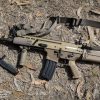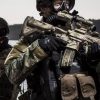Special forces operators mostly use close quarters combat or just CQC. It is a tactical concept that involves a physical confrontation between several combatants. It can occur between military units, police/corrections and criminals, and other similar scenarios. In the last 20 years, many significant events permanently changed the world. The warfare shifted from large-scale operations to the small precise raids carried by special forces.
In warfare, CQC usually consists of small specialized units or teams engaging the enemy with small arms at the concise range, up to 100 meters, from proximity hand-to-hand combat to close quarter target negotiation with short-range firearms.
In the typical close quarters combat scenario, the offenders try a swift, violent takeover of a vehicle or structure controlled by the defenders, who usually have no easy way to withdraw. Because enemies, hostages/civilians, and fellow operators can be closely intermingled, close quarters combat demands a rapid assault and a precise application of lethal force. The operators need great proficiency with their weapons and the ability to make split-second decisions to minimize accidental casualties.
Much material relating to close quarters combat is written from the authorities’ perspective, who must break into the stronghold where the opposing force has barricaded itself. Typical examples would be commando operations behind enemy lines and hostage rescues.
Since the global war on terror, many things have changed, including the close quarter’s combat tactics and techniques. Navy SEALs, Delta, Green Berets, and other SOF units are mostly unitarised in their tactics and techniques, but they are still developing their styles with a slight difference between them. I have found a rare video of Navy SEAL operators training the CQC. Since then, principles of assault have been relatively the same: detailed planning, surprise, methods of entry, speed, the violence of action.





